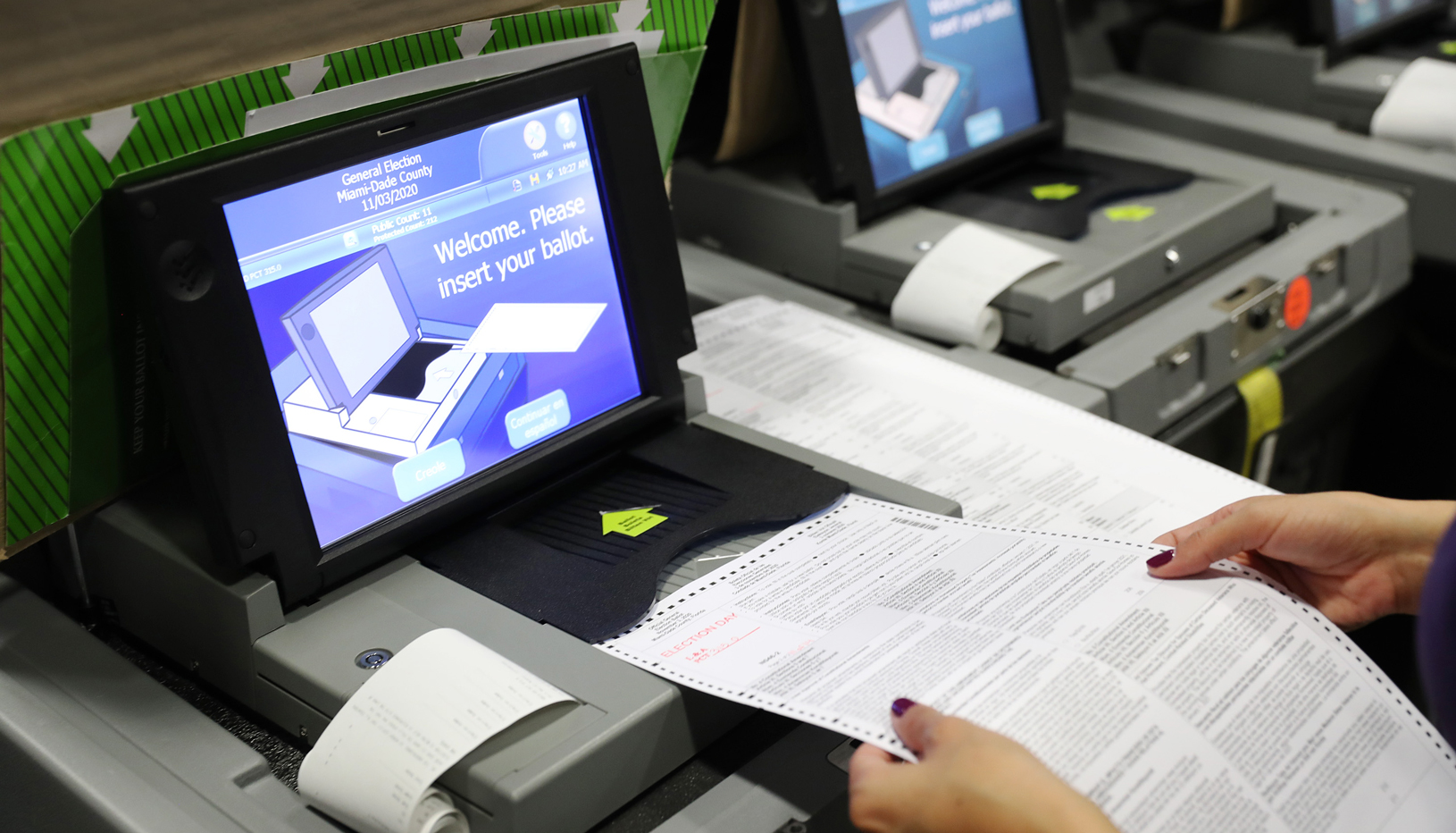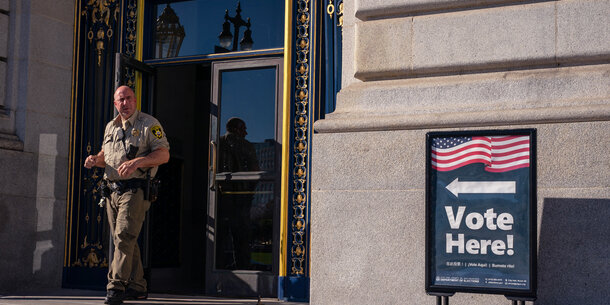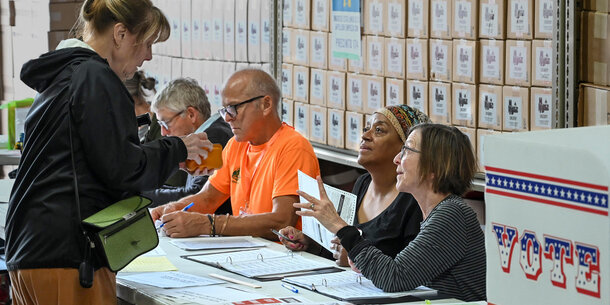How the Brennan Center arrived at its $75 million estimate for RFID key card access control systems
We estimate that, on average, key cards cost $8 per user; readers, locks, and other hardware cost $1,250 per door; access control system subscriptions and maintenance costs $1,800 per door over five years; and that the total cost per door is $3,050.1
We used Democracy Fund’s Stewards of Democracy report and EAVS 2020 data to estimate how many jurisdictions have a given number of full-time employees.2 We assumed that jurisdictions with 0 to 1 full-time employees would have three doors that require access controls and two key card users; jurisdictions with 2 to 5 full-time employees would have three doors and three users; jurisdictions with 6 to 10 full-time employees would have three doors and five users; and jurisdictions with more than 10 full-time employees would have five doors and ten users.
We multiplied the total cost per jurisdiction by the number of jurisdictions with no full-time employees ($9,165x 2,644 = $24,232,260), 1 full-time employee ($9,165 x 1,343 = $12,308,595), 2 to 5 full-time employees ($9,173 x 2,928 = $26,857,080), 6 to 10 full-time employees ($9,188 x 533 =$4,896,938), and more than 10 full-time employees ($15,325 x 450 = $6,896,250). The sum of these figures is $75,191,123
How the Brennan Center arrived at its $197 million estimate for asset tracking systems
We used EAVS 2020 data to determine the total precincts on Election Day (176,933). Based on data from Verified Voting, we estimate that there are at least 369,366 total voting machines nationwide, which includes DREs, BMDs, and scanners (data for some jurisdictions is unavailable).
We estimate that the average cost of one asset tag is $60, with $5 per tag in monthly service fees ($300 over five years).3
To calculate the total cost for one asset tag per precinct, we multiplied the total number of precincts by the total five-year cost per tag ($360), which amounts to $63,695,880.
To get the total cost of one asset tag per machine, we multiplied the total five-year cost per tag ($360) by the total voting machines, which amounts to $132,971,760.
We added these two costs ($63,695,880 and $133,200,000) for a total of $196,667,640.
How the Brennan Center arrived at its $27 million estimate for camera surveillance
We estimate that the average camera costs $750 and that the cost of data storage over five years is $600.4 We assumed that jurisdictions with 0 to 1 full-time employees would need two cameras; jurisdictions with 2 to 10 full-time employees would need five cameras; and jurisdictions with 10 or more full-time employees would need 10 cameras.
We multiplied the cost per jurisdiction by the number of jurisdictions with no full-time employees ($2,100 x 2,644 = $5,552,400), 1 full-time employee ($2,100 x 1,343 = $2,820,300), 2 to 5 full-time employees ($4,350 x 2,928 = $12,736,800), 6 to 10 full-time employees ($4,350 x 533 = $2,318,550), and more than 10 full-time employees ($8,100 x 450 =$3,645,000). The sum of these figures amounts to $27,073,050.
How the Brennan Center arrived at its $17 million estimate for voter registration & election management system access controls
For this estimate, we used $375 for the endpoint protection cost per user for five years, $180 for the multi-factor authentication cost per user over five years, and $1,000 for virtual private network and system access costs per jurisdiction over five years.5
We assumed that jurisdictions with 0 to 1 full-time employees would have 1 user; jurisdictions with 2 to 5 full-time employees would have 2 users; jurisdictions with 6 to 10 full-time employees would have 3 users; and jurisdictions with more than 10 full-time employees would have 10 users.
We multiplied the total cost per jurisdiction by the number of jurisdictions with no full-time employees ($1,555 x 2,644 = $4,111,420), 1 full time employee ($1,555 x 1,343 = $2,088,365), 2 to 5 full-time employees ($2,110 x 2,928 = $6,178,080), 6 to 10 full-time employees ($2,665 x 533 = $1,420,445), and more than 10 full-time employees ($6,550 x 450 = $2,947,500). The sum of these figures amounts to $16,745,810.
Endnotes
-
1
For typical costs of key card access control systems, see, e.g., Bernhard Mehl, “Access Control Systems Cost: Installation and Price per Door,” Kisi blog, February 25, 2021, https://www.getkisi.com/blog/breakdown-of-access-control-system-installation-costs; Brian Rhodes, “Designing Access Control Guide,” internet Protocol Video Market, January 30, 2019, https://ipvm.com/reports/designing-an-access-control-system; Ackerman Security, “Average Cost per Door for Access Control,” last accessed March 7, 2022, https://www.ackermansecurity.com/blog/business-security/average-cost-access-control; ButterflyMX, “Video Intercom Cost,” last accessed March 7, 2022, https://butterflymx.com/cost/; and Salto Systems, “Home,” last accessed March 7, 2022, https://saltoks.com/. -
2
Jurisdiction size estimates based on data from EAVS 2020. U.S. Election Assistance Commission, “Studies and Reports,” last accessed March 7, 2022, https://www.eac.gov/research-and-data/studies-and-reports; and Natalie Adona et al., “Stewards of Democracy,” Democracy Fund, 2019, https://democracyfund.org/wp-content/uploads/2020/06/2019_DemocracyFund_StewardsOfDemocracy.pdf. -
3
Based on unit cost estimates provided by Mason County, WA. -
4
For typical costs of camera surveillance equipment for government facilities, see, e.g., https://online.ogs.ny.gov/purchase/spg/pdfdocs/3880622844PL_AudioEnhancement.pdf. -
5
See Christopher R. Deluzio et al., “Ensuring Safe Elections,” Brennan Center for Justice, 2020, https://www.brennancenter.org/our-work/research-reports/ensuring-safe-elections.





